Agamon Hula – Must For Bird Lovers – Visitors Guide
Agamon Hula is a wetland habitat in northern Israel. And during each migration season, millions of birds fly over the Hula Valley. Hence, it is the perfect place for bird watching.
Note: For additional info about animals and wildlife, check out Zoos and Aquariums in Israel.
Note 2: There is a common mix-up between Hula Nature Reserve and Agamon Hula. These are two different places, which are both located in the Hula Valley. Сheck out Agamon Hula versus Hula Nature Reserve – Which one is Better? for a comparison of the two places.
I visited Agamon Hula more than a dozen times, and this post contains my impressions and photos from some of those visits. Before we start with basic info, I want to share two important tips. First of all, visit only during the migration season. And secondly, if you can, join one of the tours.
Table of Contents
Map
Agamon Hula is located 15 km south of Kiryat Shmona. It is also near Hula Nature Reserve. On the following map, you can see Agamon Hula to the north and Hula Nature Reserve to the south.
Directions for drivers: Link to Waze and Link to Google Maps
Directions for public transport: Link to Moovit
Interactive map of the area:
And here is a map of Agamon Hula:
Trails
The length of the trail at Agamon Hula is 9.5 km, and it is marked in red on the map below.
Here is an interactive map from israelhiking.osm.org.il:
Directions
You can reach Agamon Hula either by car or by bus. If you arrive by car, enter “Agamon Hula” into your navigation app. And if you choose public transport, you can see directions at Moovit. Follow this link and enter your starting point to get the updated instructions.
Opening Hours
Sunday – Thursday: 08:00 – 19:00
Friday and Saturday: 06:30 – 19:00
Note: you can enter the site until 17:30.
Entrance Fee
Agamon Hula is much bigger than Hula Nature Reserve, and the round trail is around 9.5 km (see the map above). Thus, you have several options to complete the path. You can walk, rent a bicycle, rent a golf cart, or join a tour.
| Price (NIS) | Notes | |
| Entrance – Adult | 35 | |
| Entrance – Child (5 – 18 years old) | 21 | |
| Entrance – Student | 30 | |
| A bicycle per adult | 50 | Rental time is limited to three hours. |
| A bicycle per child | 42 | Rental time is limited to three hours. |
| Golf Cart for two people | 149 | Rental time is limited to 75 minutes. |
| Golf Cart for four people | 199 | Rental time is limited to 75 minutes. |
| Golf Cart for six people | 259 | Rental time is limited to 75 minutes. |
| Sunrise Tour | 85 NIS per adult and 65 NIS per child (3-12) | Duration: two hours. You have to register in advance. |
| Night Tour | 85 NIS per adult and 65 NIS per child (3-12) | Duration: 1.5 hours. You have to register in advance. |
| Safari Wagon Tour | 59 NIS per adult and 51 NIS per child (3-12) | Duration: one hour. You have to register in advance. You can do this on-site. |
| Sunset Tour | 64 NIS per adult and 55 NIS per child (3-12) | Duration: 1.5 hours. You have to register in advance. |
| Renting binoculars and a guide | 20 |
Note: during the peak season (migration peak), they might run out of Golf Carts and Bicycles. Thus, I would suggest coming early.
These are the most popular options, but there are several others. For the complete list, visit the official site.
Note: Opening hours and entrance fees were updated in April 2021. In any case, recheck the official site before visiting.
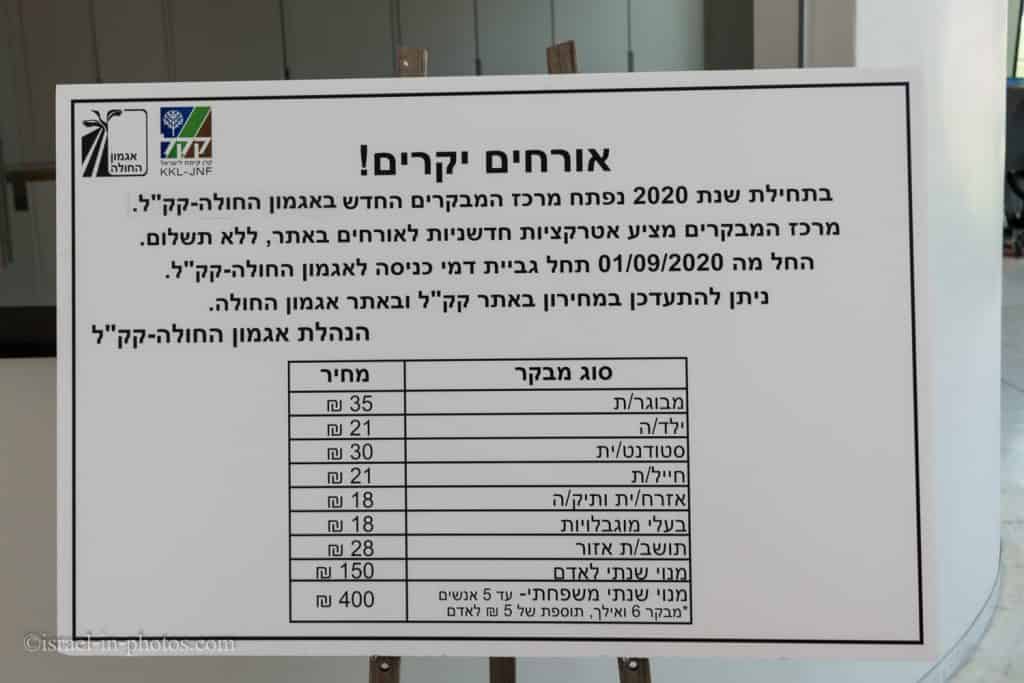
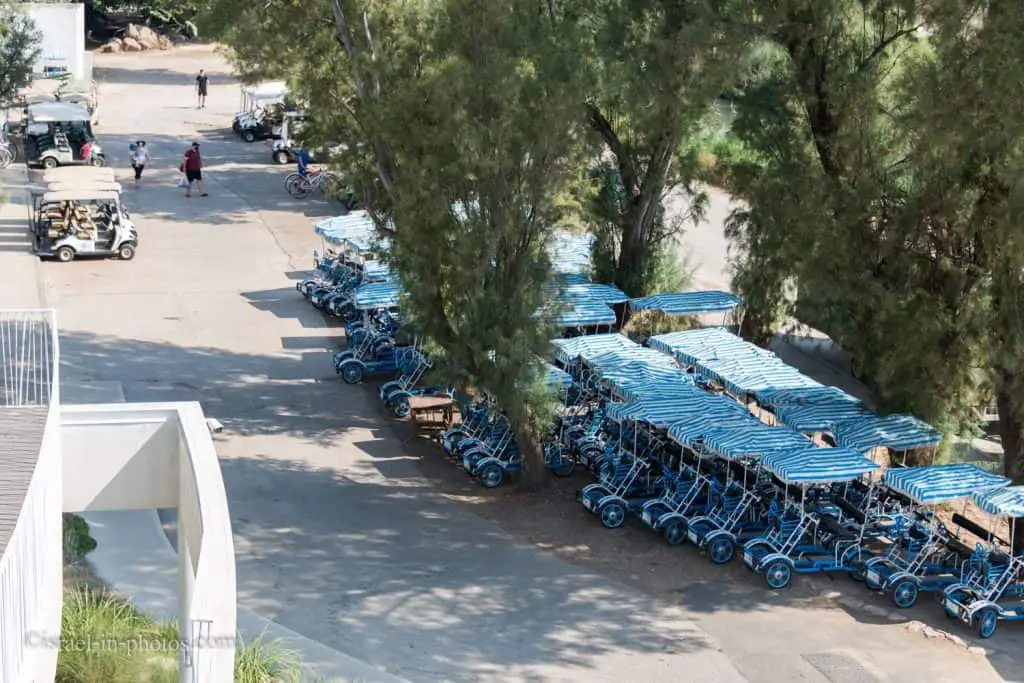
If you visit on a regular day (not a holiday or on the weekend), you can bring your bicycle. In that case, you will pay only the entrance fee mentioned above. Also, if you decide to walk, you will spend the same amount.
What is the Best Time to Visit Hula Valley?
The best time for a visit is during bird migration, which means either fall or spring (usually March – April and October – November). If you want to know the exact dates and what birds are currently there, follow Agamon on social media (here is a link to their Facebook page).
The best time of day is either early in the morning or late afternoon (towards sunset). During these hours, the cranes (and many other species of birds), like most wildlife, are most active. That is also why they offer sunrise and sunset tours.
Visitor Center
Towards the end of 2020, a new visitor center was opened.

But when we came for a visit in August 2020, all the attractions inside the visitor center were closed due to the Coronavirus.
One compelling feature of this building is the viewpoint on top of it. You can either walk up the stairs or take an elevator. And though it is a lovely idea, this viewpoint does not provide exceptional views.
Agamon Hula With Kids
On most visits, we took our kids with us (the only times we traveled alone were when I knew I wanted to stay longer and take more photos). Many people do the same, and there are plenty of kids there. It is a family attraction, and you should not be afraid to take children.
Tours At Agamon
Tour Languages
On all the tours I joined (Safari Wagon tours and Sunrise tours), the guide gave explanations in Hebrew. If you are interested in tours in another language, I would suggest contacting Agamon either by using the contact form on the official site or by phone at +972-4-6817137.
Safari Wagon
During my first several visits to Agamon, I cycled. But the problem is that you cannot get too close to birds and see them from a distance. Thus, after several regular visits, I started to join the Safari Wagon tour.
While on-site, you register and pay for a Safari Wagon tour. And then you will need to wait (usually up to half an hour) for the beginning.

Usually, birds are afraid of humans and keep their distance. Moreover, it would help if you had binoculars or a long lens to see or photograph them. One way to get around that is by hiding, and another is gaining an animal’s trust.
The safari wagon is a combination. Firstly, you sit in a towed vehicle (by a tractor). Although it is open on one side, you are asked to keep quiet so you will not frighten the birds. Secondly, the same tractors are used to feed the birds. And since birds are used to those tractors, they come close to them. But those tractors supply food primarily for cranes during the migration season. Thus, it is less likely that you will see other birds from such a close distance. Songbirds and pray birds will keep their distance from the safari wagon.
Another critical factor is that the safari wagon enters areas you can not enter by foot or bicycle.
The duration of a safari wagon is about 40-60 minutes. And if you want an even better experience, I suggest the Sunrise Tour. These tours are also done in safari wagons, but they are made during sunrise, which is a magical time (not only in photography but also when the birds wake up and fly for breakfast).
Here are several of my shots from Safari Wagons.
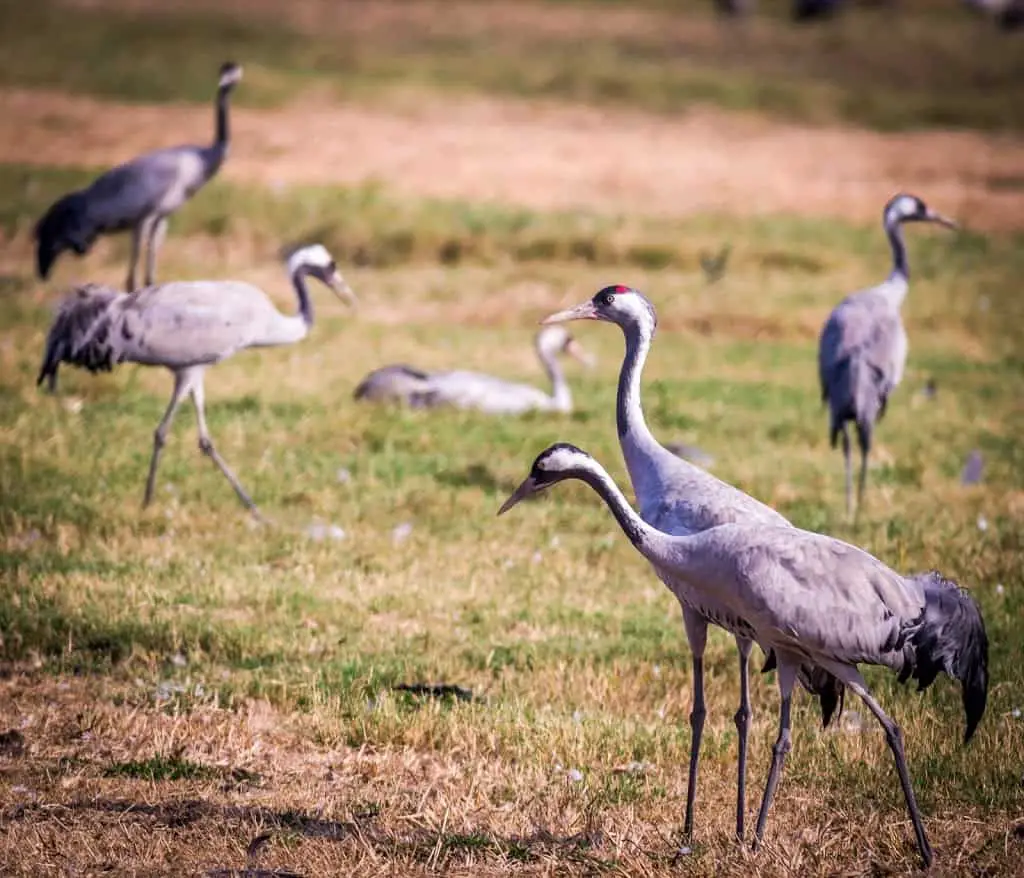
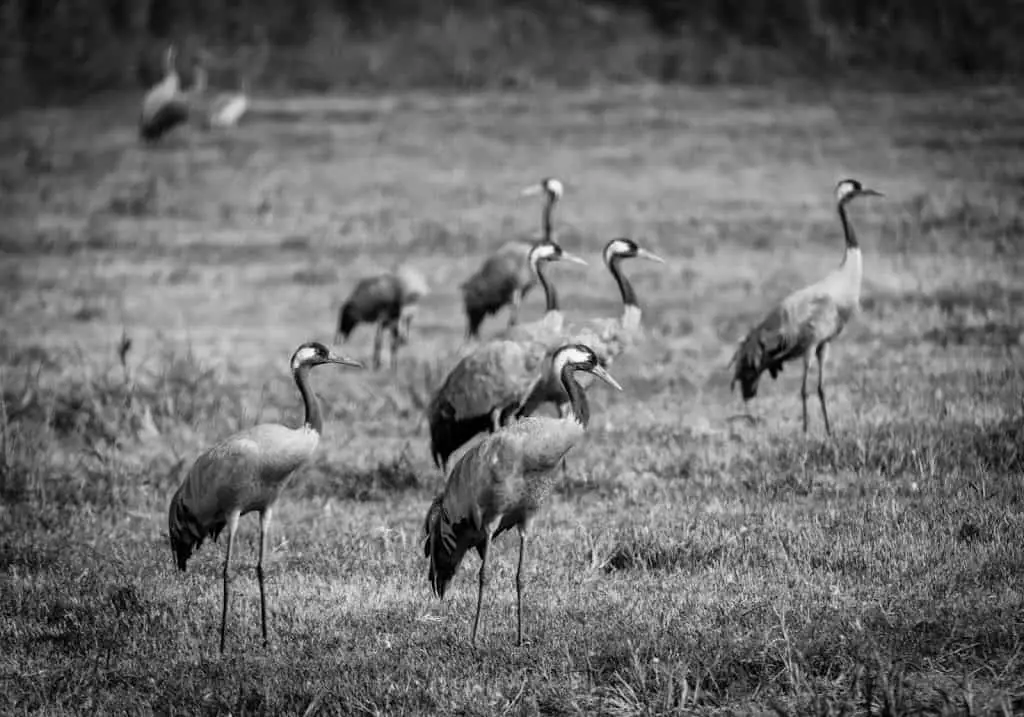
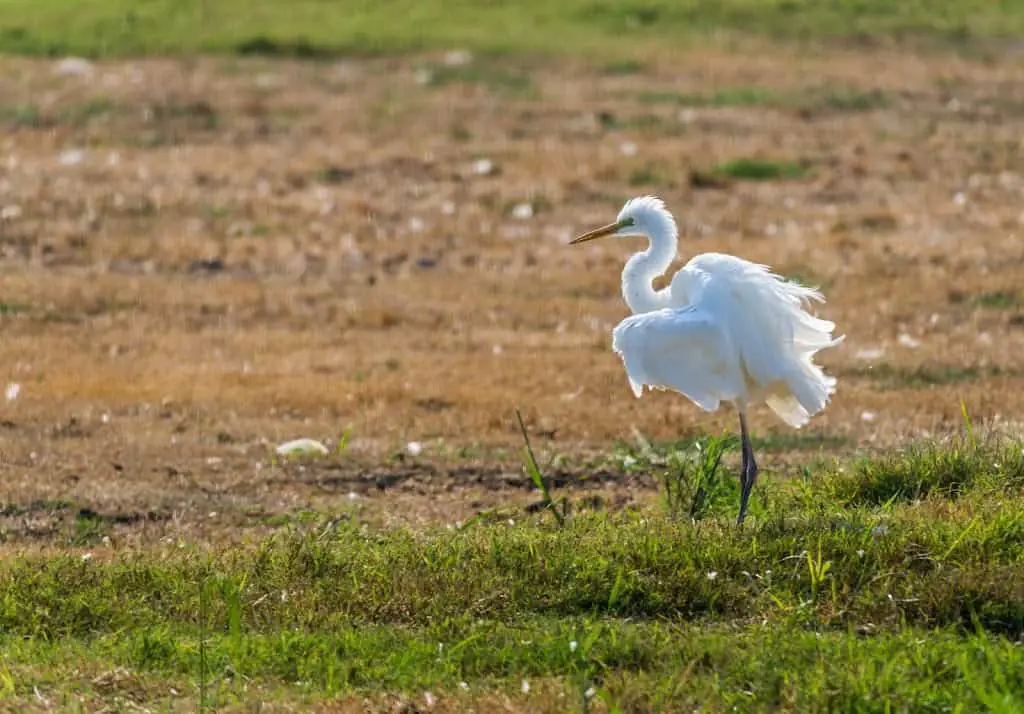
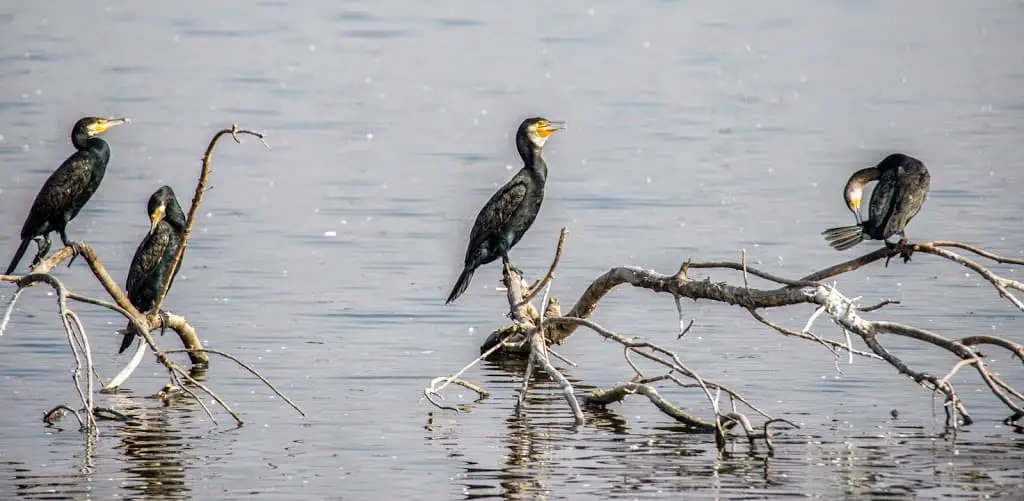
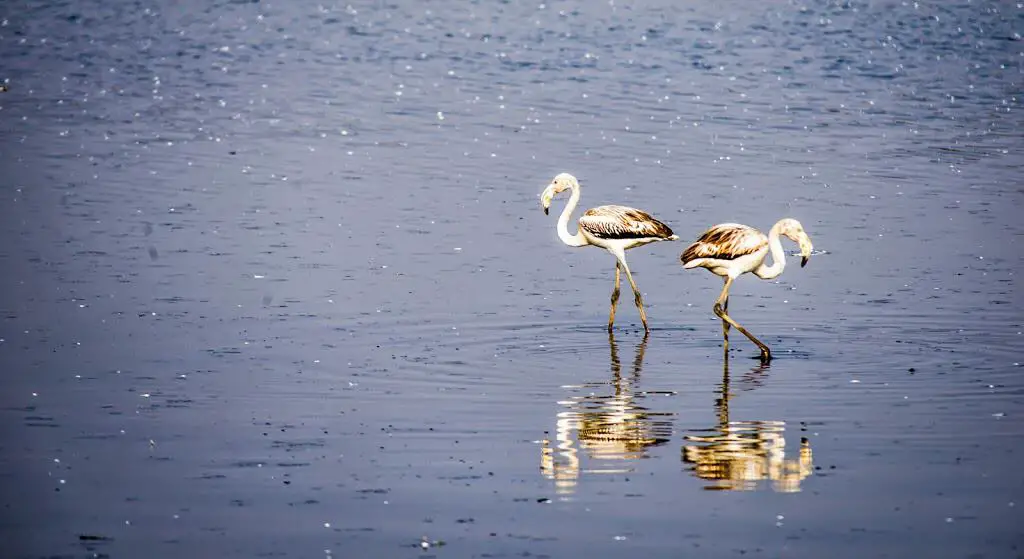
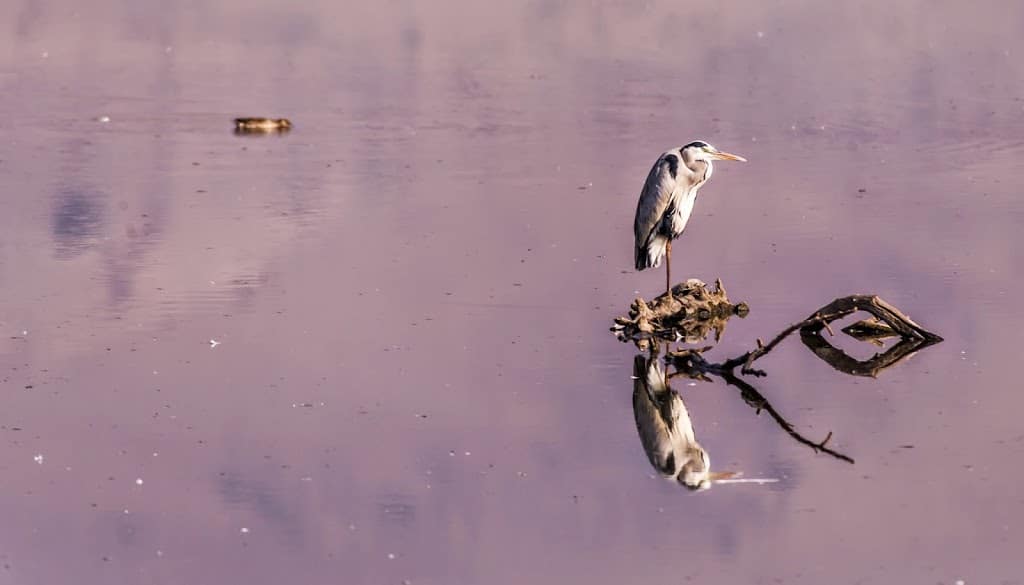
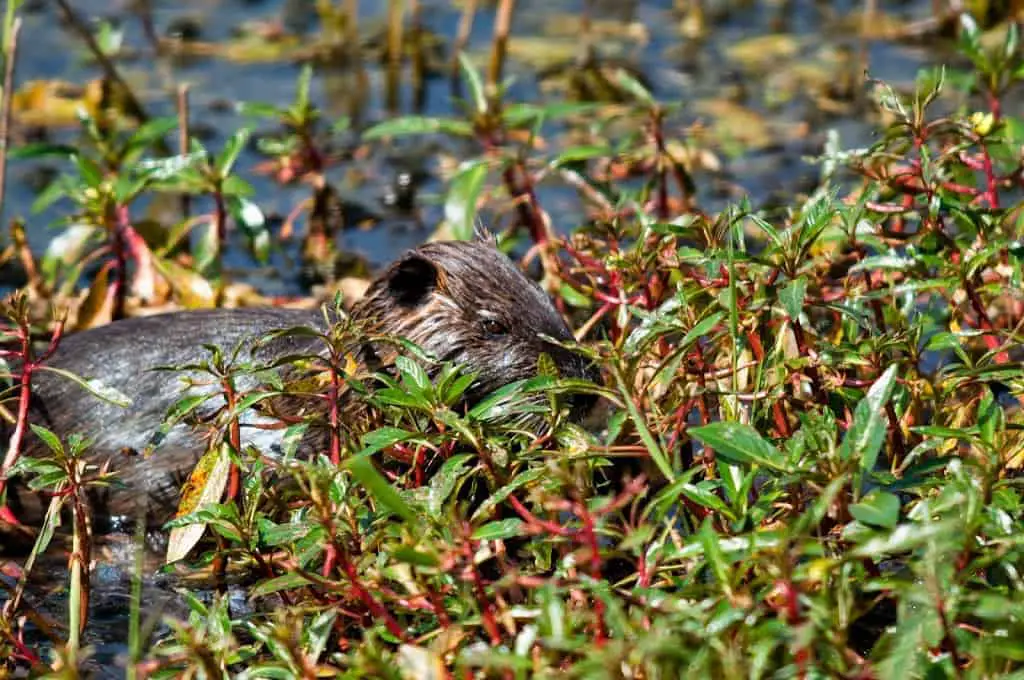
You can find Nutrias in Agamon and Ein Afek Nature Reserve, and I wrote about their history in Israel at Nutria (Coypu).
The Sunrise Tour
At the top of this post, you saw a short video from the Agamon Hula sunrise tour. You can see about 50,000 cranes in the video, which is still not the peak.
Two exciting and less familiar facts about cranes:
- In the video, you can see that while some cranes were eating, others were on guard. You can never see all cranes with their heads down.
- Cranes, similarly to swans, also have one partner per life. Moreover, they renew their “marriage vows” each year by performing their mating dances.
You need to sign up in advance for the sunrise tour. Preferably several weeks in advance during the peak season.
We arrived at 5:10 am, and the tour started at 5:30.
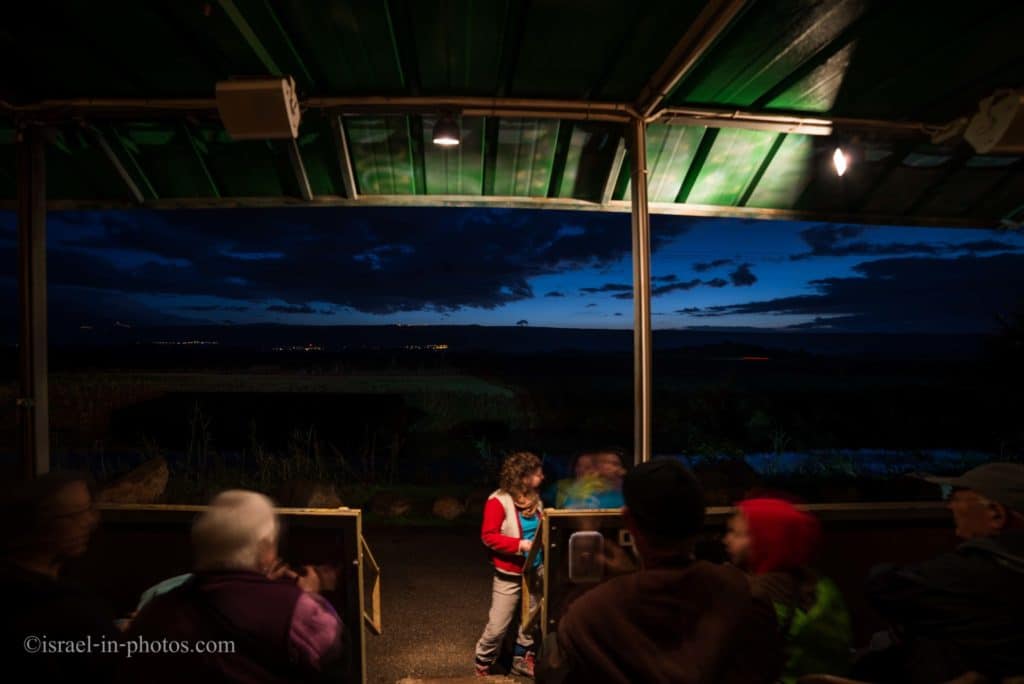
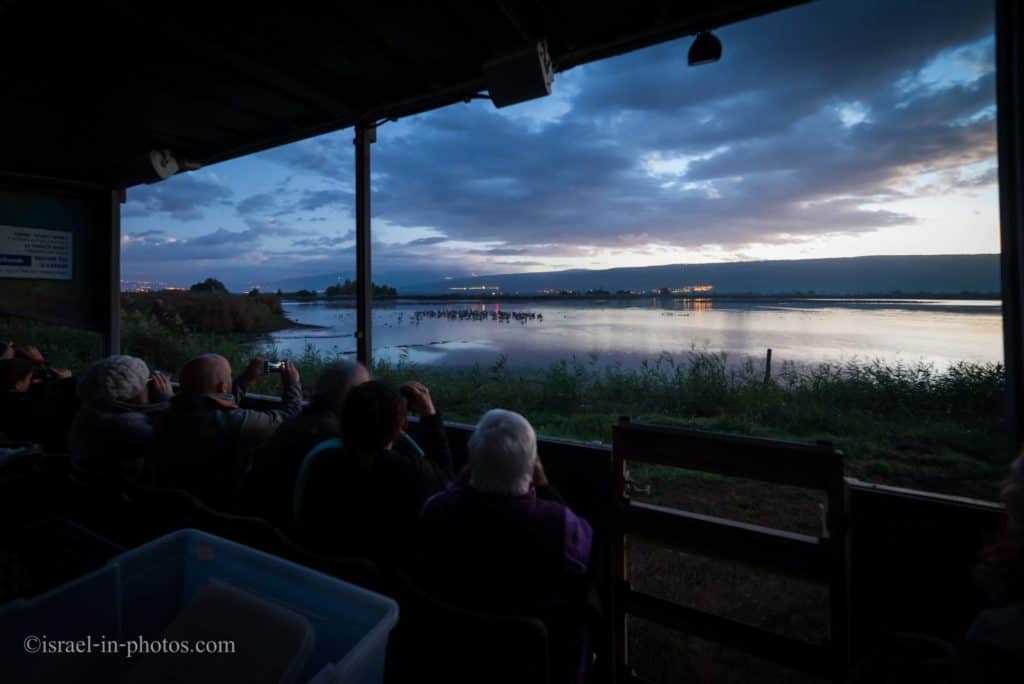
Sitting in the carriage connected to a tractor, our guide performs the last checks before departure.
Why carriage? Years ago, one of the farmers noticed that birds are not afraid of tractors. They are used to them since people use tractors to feed the birds. Thus, birds come close. Since then, touristic carriages have been constructed. These carriages are connected to tractors so you can get close to the birds. Each carriage has three (inclined) rows and about 40 seats.
The photo above shows the view from the third row of the carriage. The box at the bottom of the image is one of the several boxes with warm blankets and binoculars prepared in advance for us.
Common Cranes
Our first stop was to greet common cranes before they woke up:
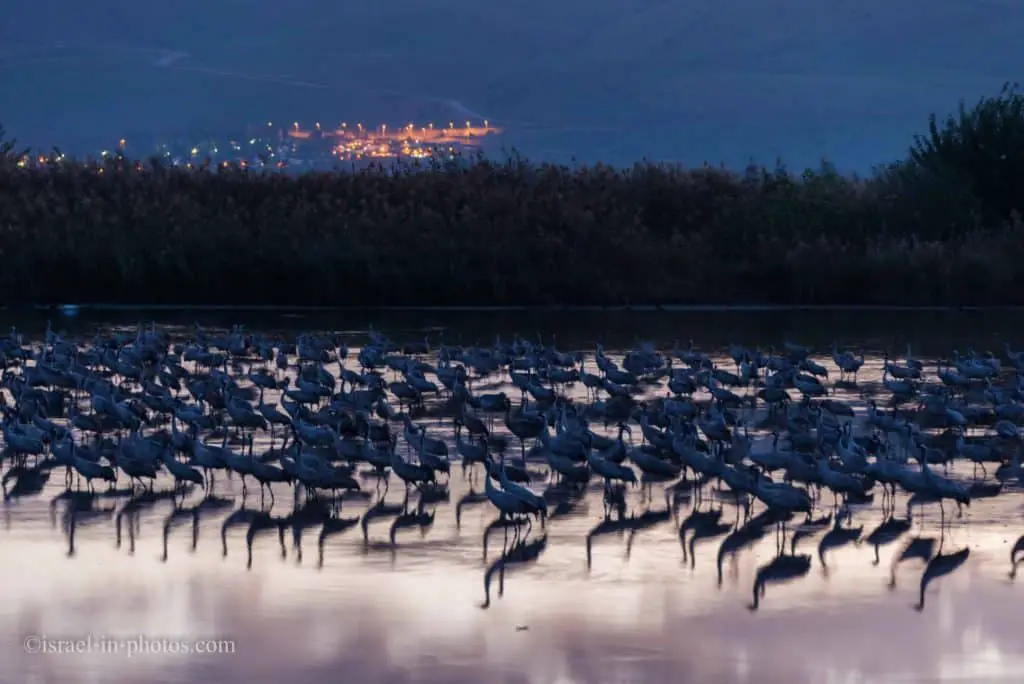

The sun starts to rise, and the cranes begin to fly.
The cranes sleep in shallow water lakes (the depth is, on average, 30 cm, and a series of dams control it). The water offers protection from predators. Birds can sense water movement over long distances, making it hard to get closer without being noticed.
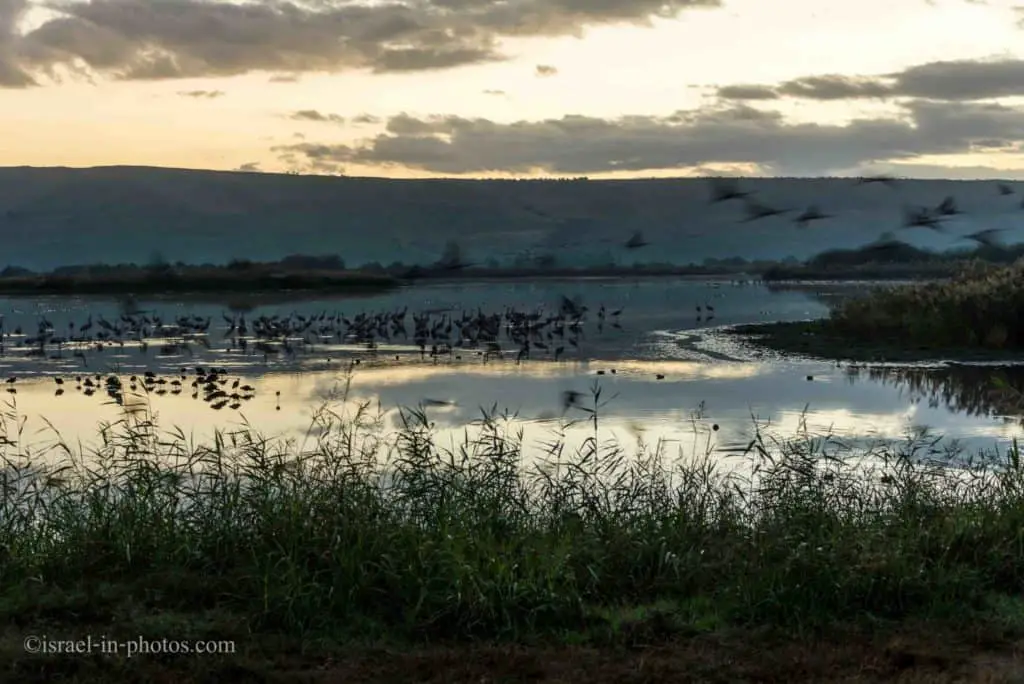
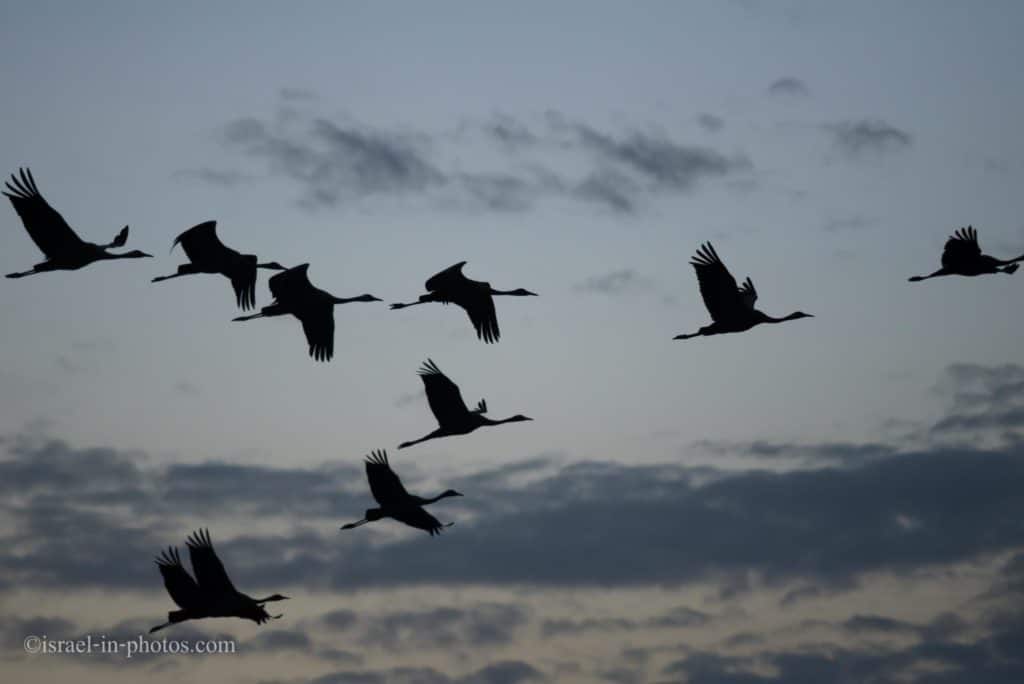
Then, we drove to the crane feeding grounds. Here is a feeding tractor in action:
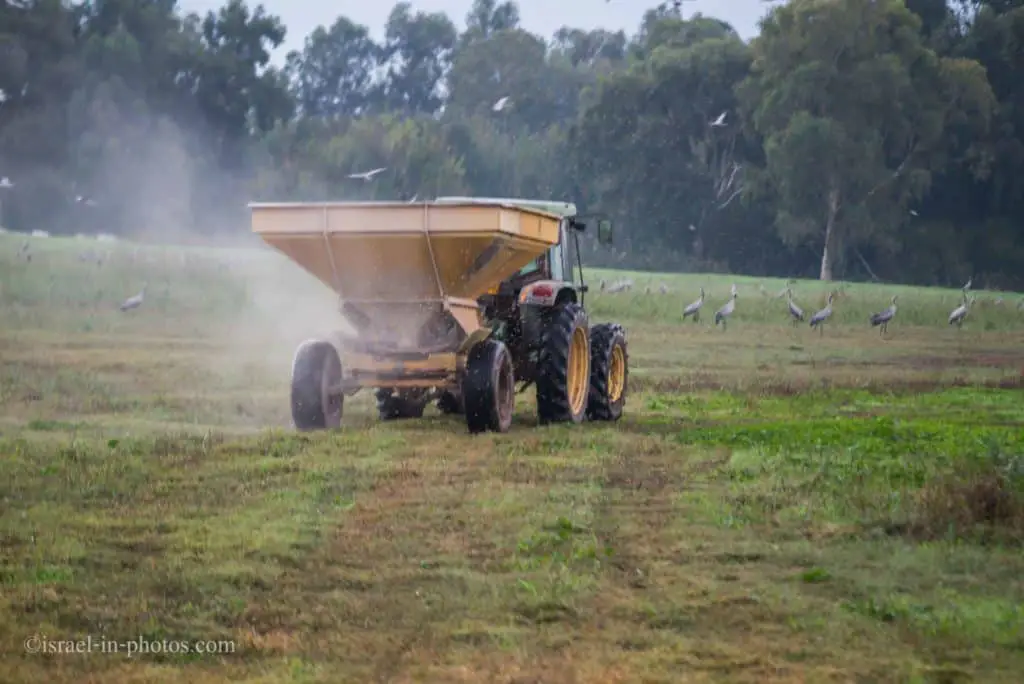
They are fed with corn.
Cranes, like other birds, cross over Israel in the winter. Around 500 million birds pass annually. It can cause severe damage to agriculture. Thus, feeding was organized at Agamon Hula. And Rangers patrol fields with sound guns. If they spot birds, they scare them off, intending to direct them to Agamon. As a result, birds learn there is food, and more cranes come along each year.
Note: not all cranes continue their migration to Africa. And since there is food here, many decide to stop their migration. According to different estimations, in 2019, 35,000 to 50,000 cranes will be spending their winter in Israel (and leave in March).
Until several years ago, the farmers whose fields were protected paid for the corn, but a new income source had to be found as the number of cranes increased. Today, the tourists pay for the rest.
Our sunrise tour was not the only one that morning. There was also a sunrise tour for photographers.
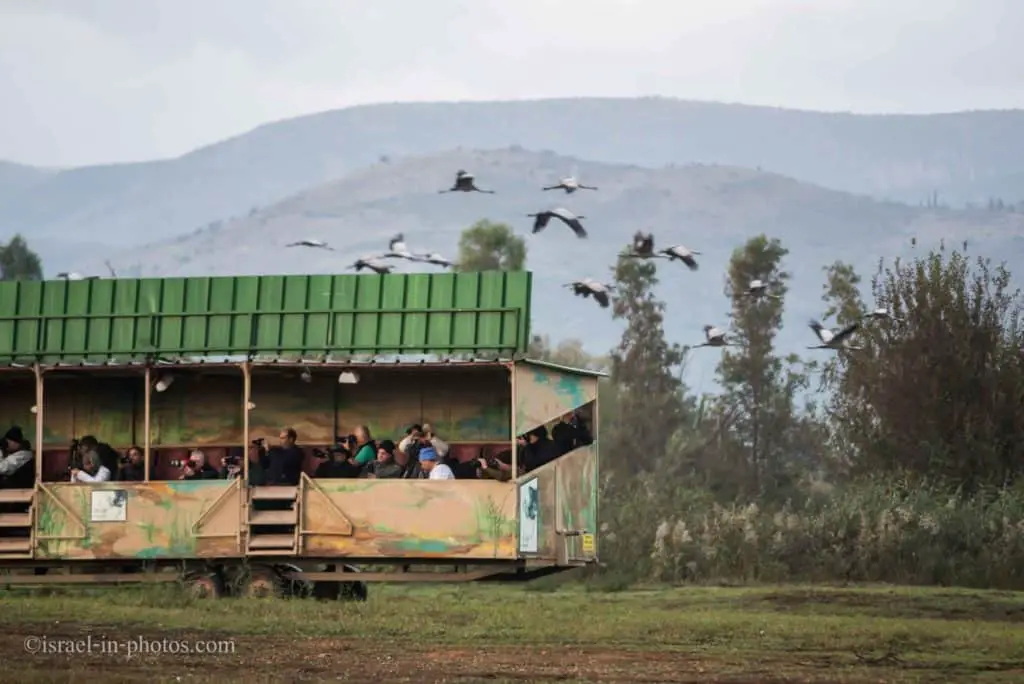
As I mentioned above, somebody is always on guard. There is no second when all cranes eat together:
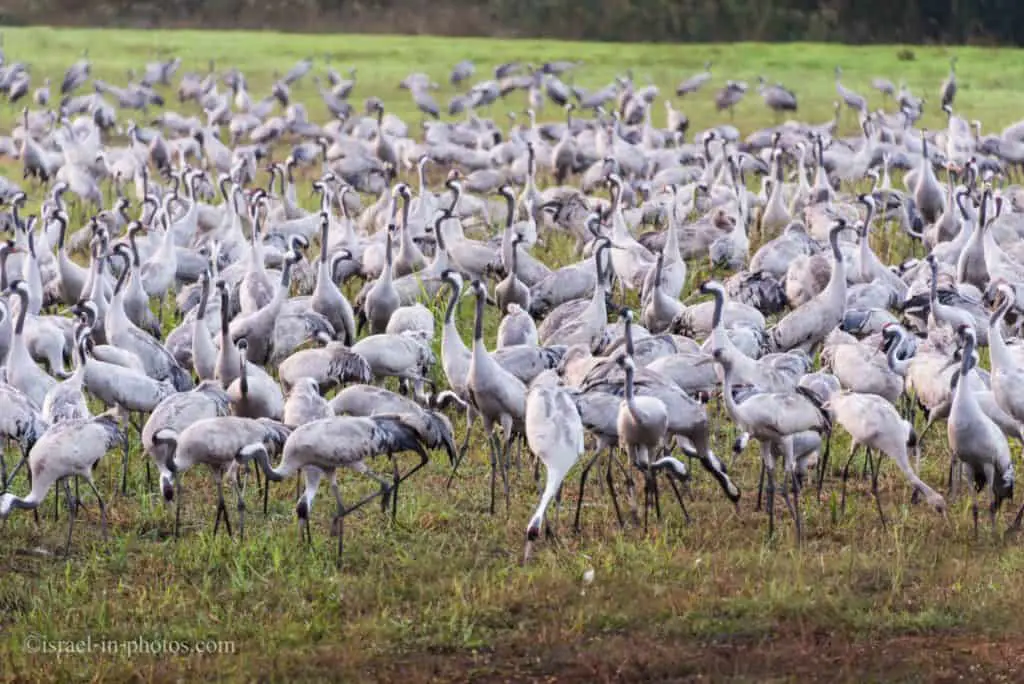
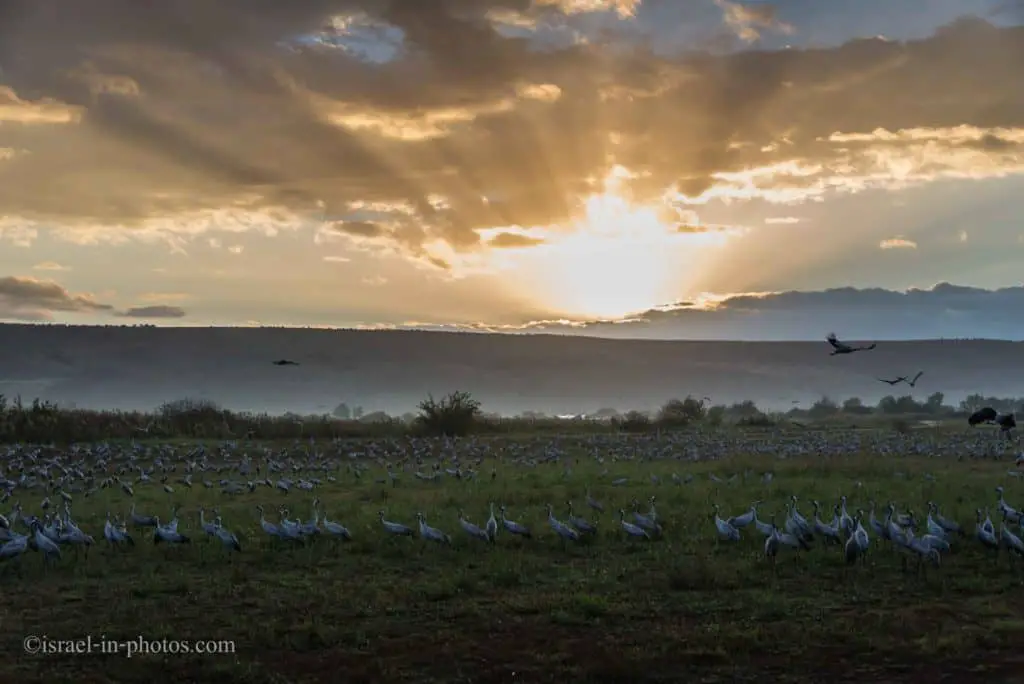
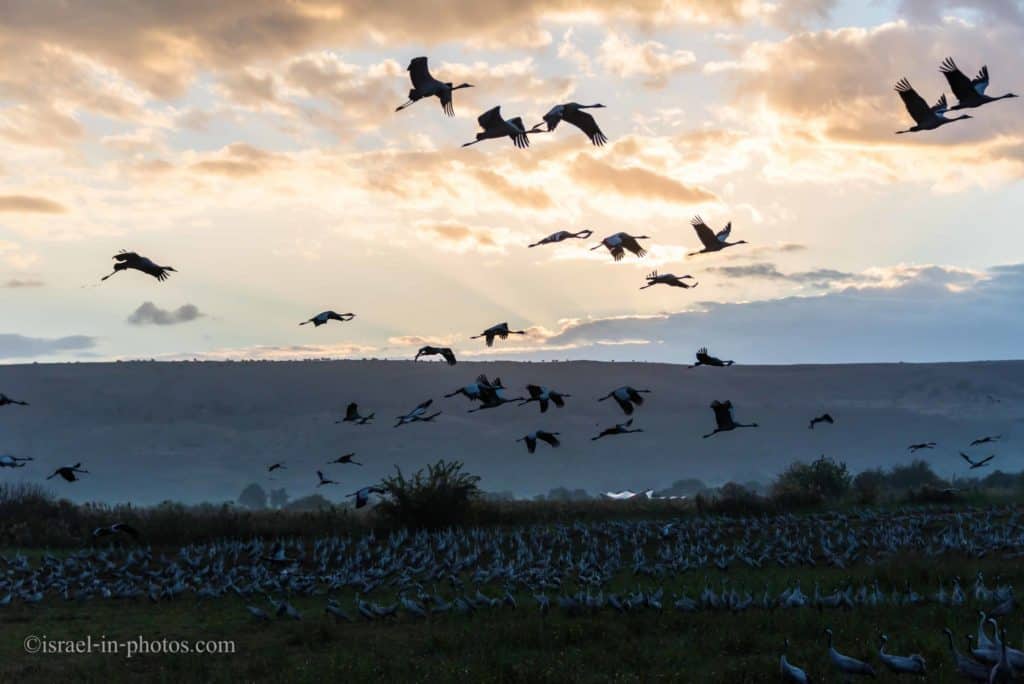
On our visit, about 50,000 cranes were in the Agamon. Nonetheless, they all flew together, and there were no accidents.
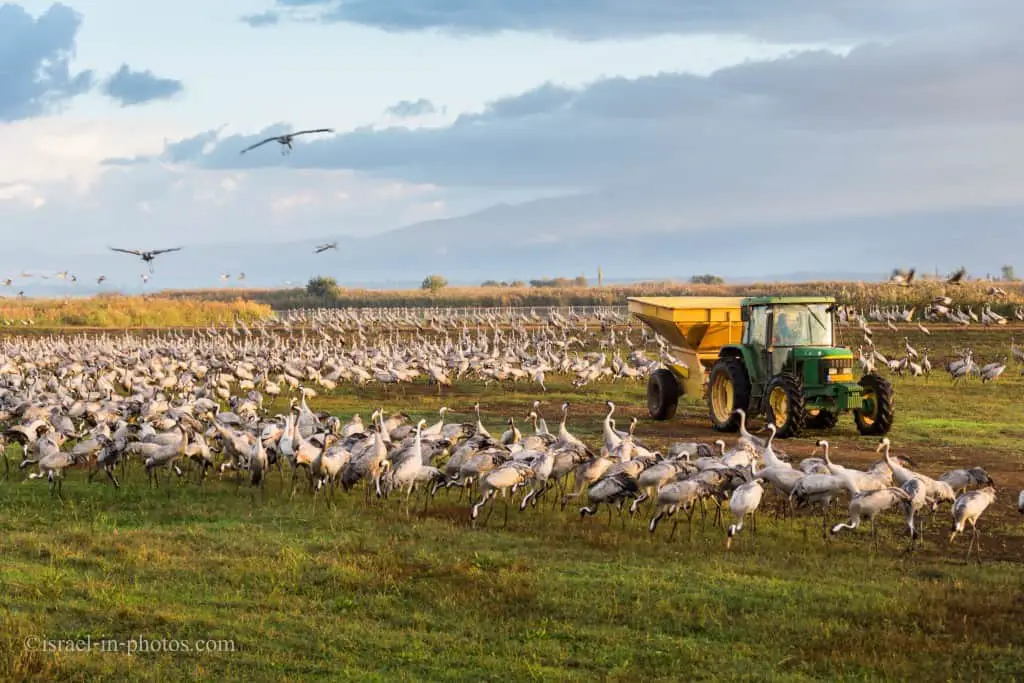
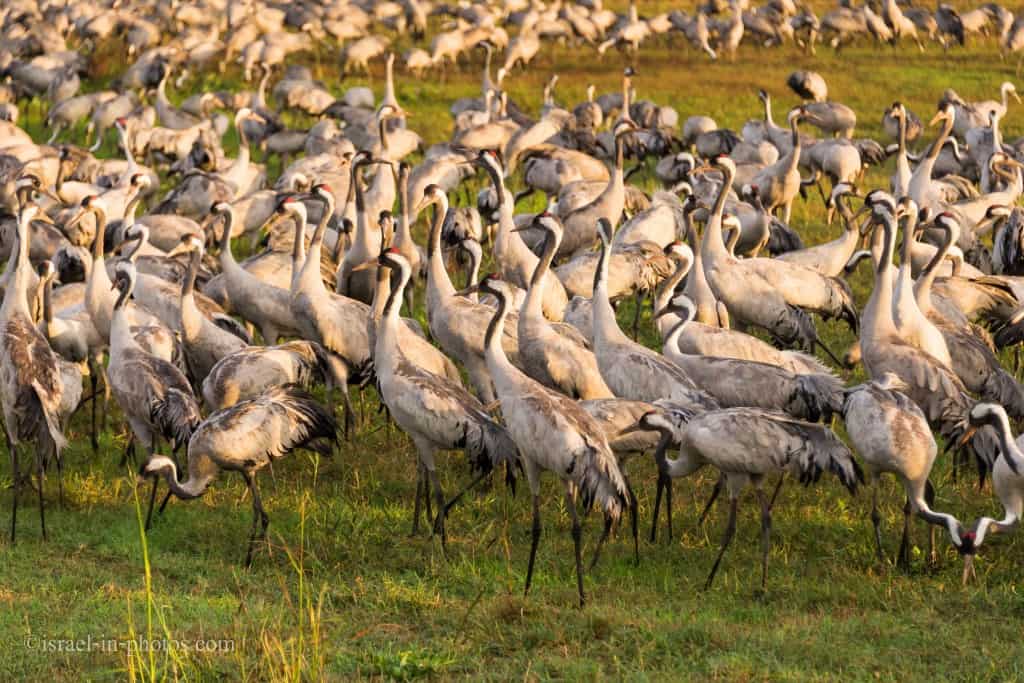
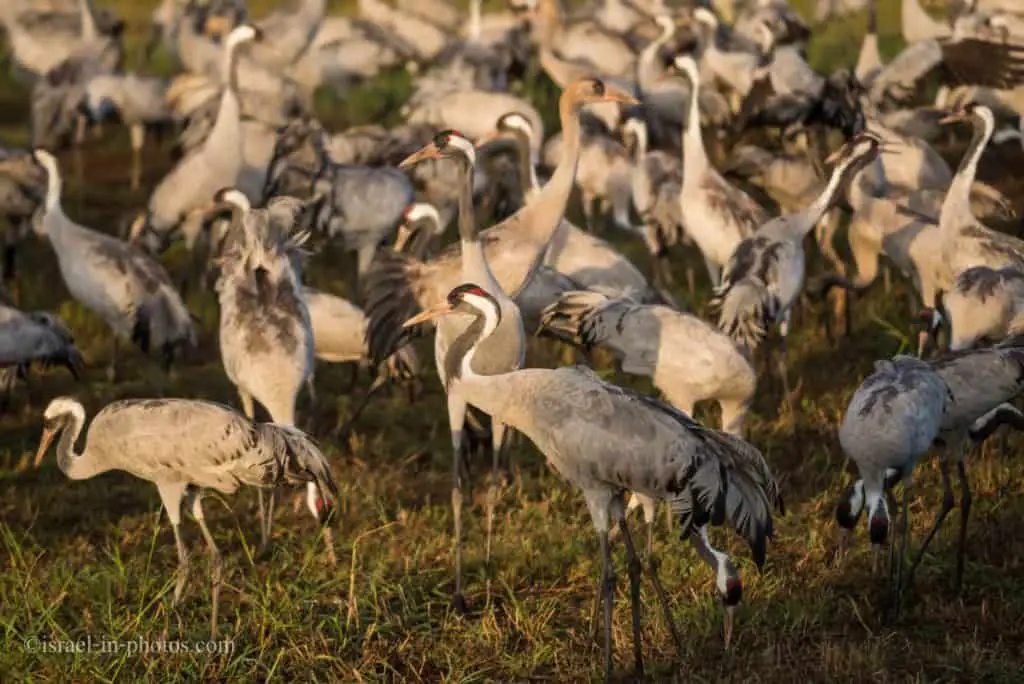
We were lucky to see a rainbow:
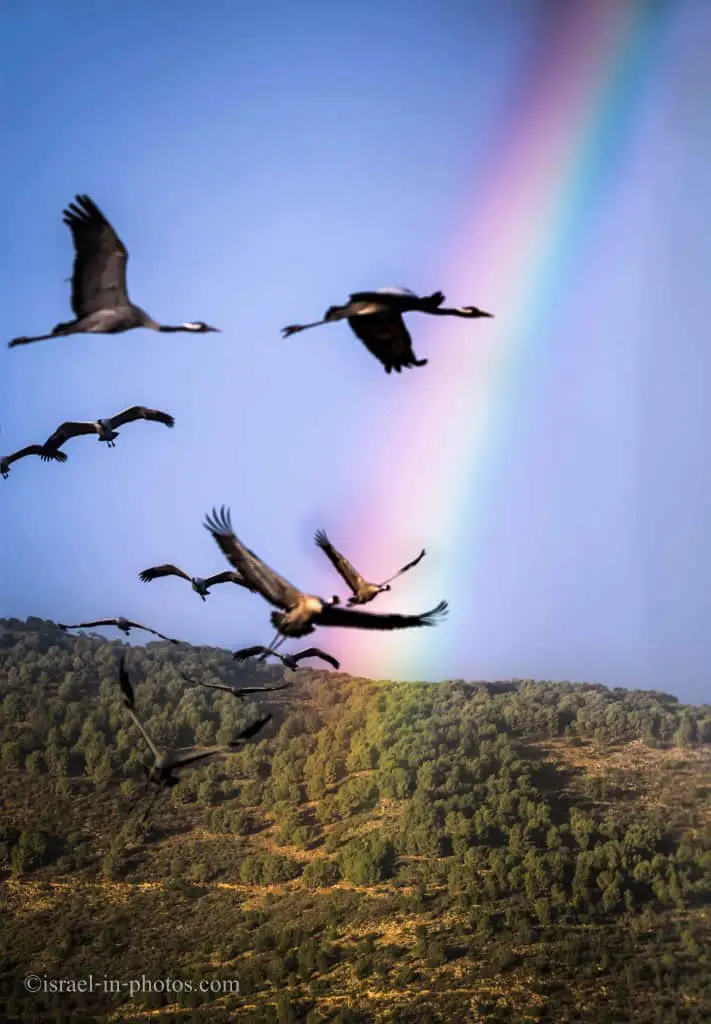
And here is the complete rainbow (using a wide-angle lens [14mm]):
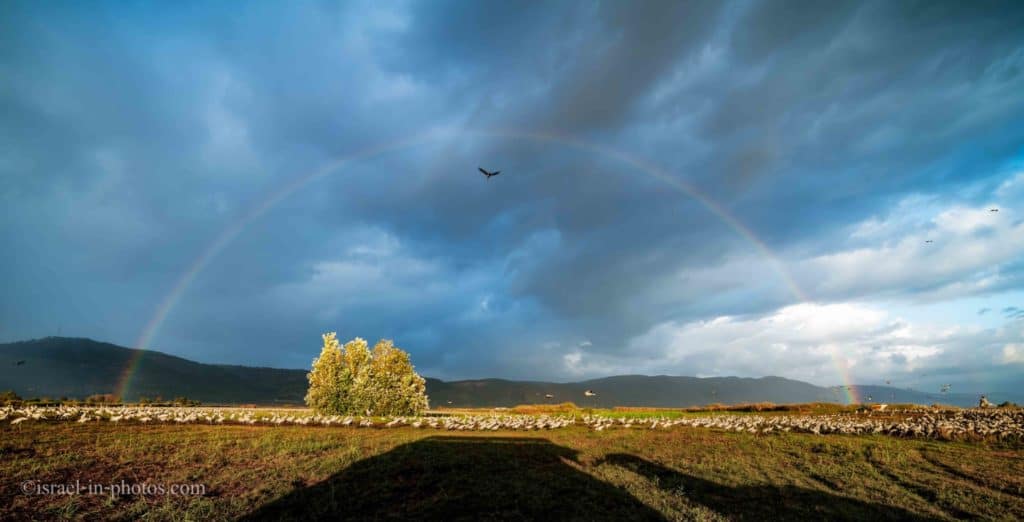
Other Species Of Birds
Cranes were the main attraction. Unfortunately, the pelicans have already left :(
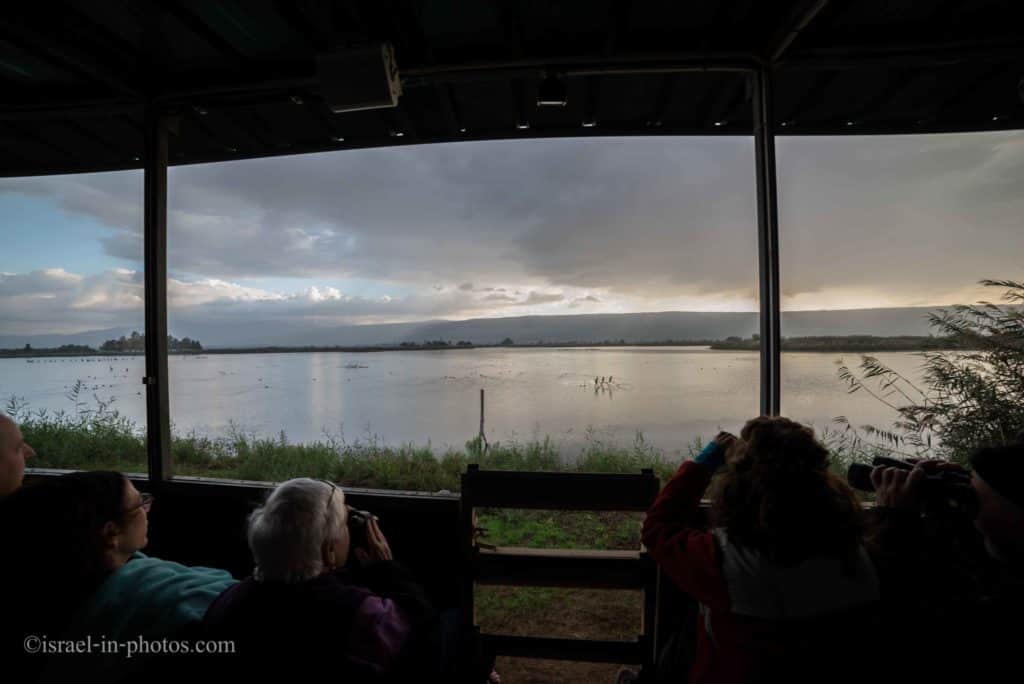
If you are interested in seeing pelicans, there’s another place in Israel where you can do so. Check out Pelican migration at Emek Hefer.
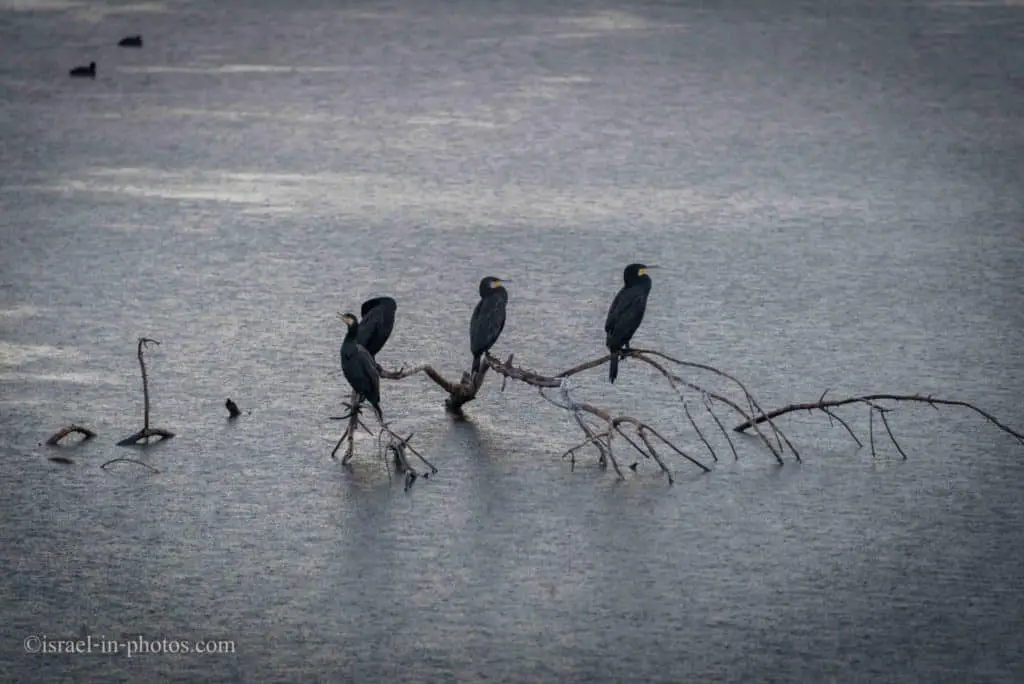
Cormorants have been used as skilled fishers in China and Japan for centuries.
Some cormorant species have been found, using depth gauges, to dive to depths of as much as 45 meters.
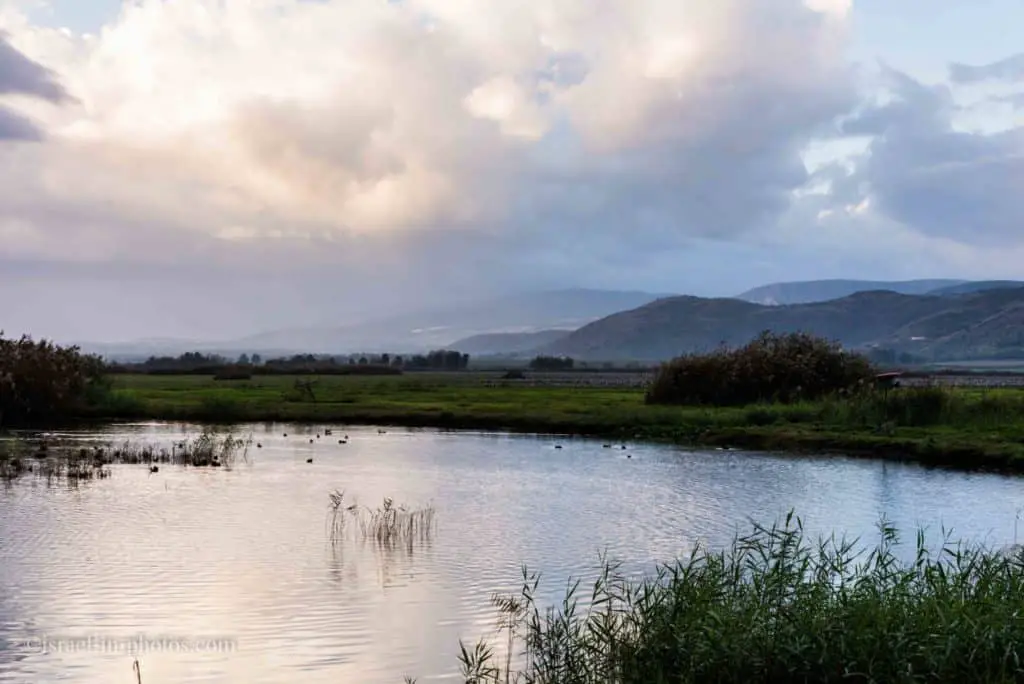
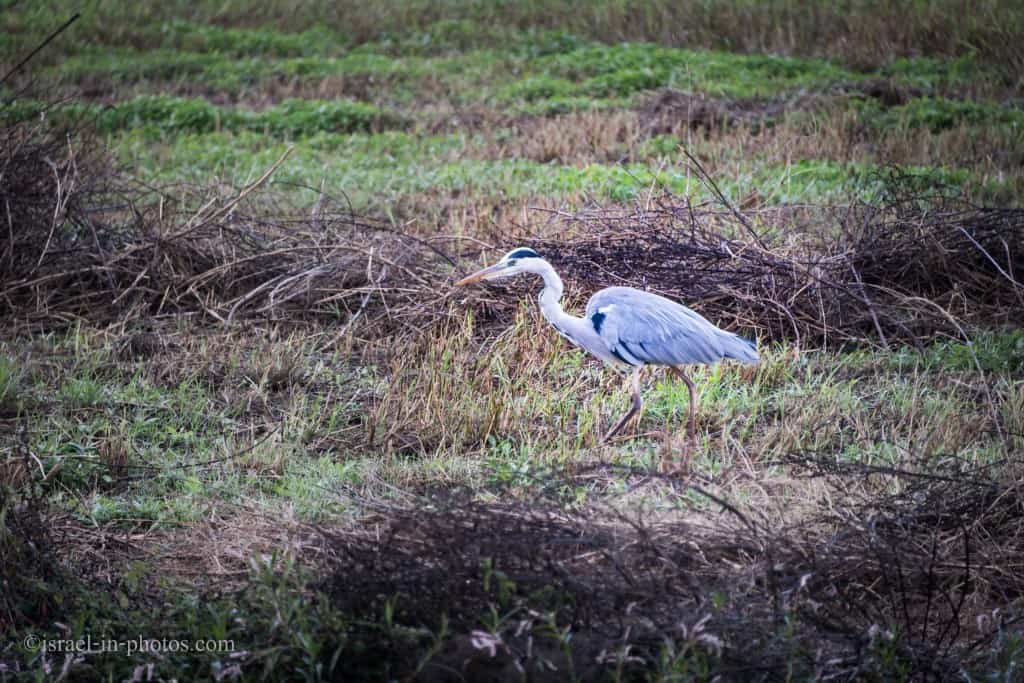
Predators are hard to see (since humans do not feed them, they keep their distance):
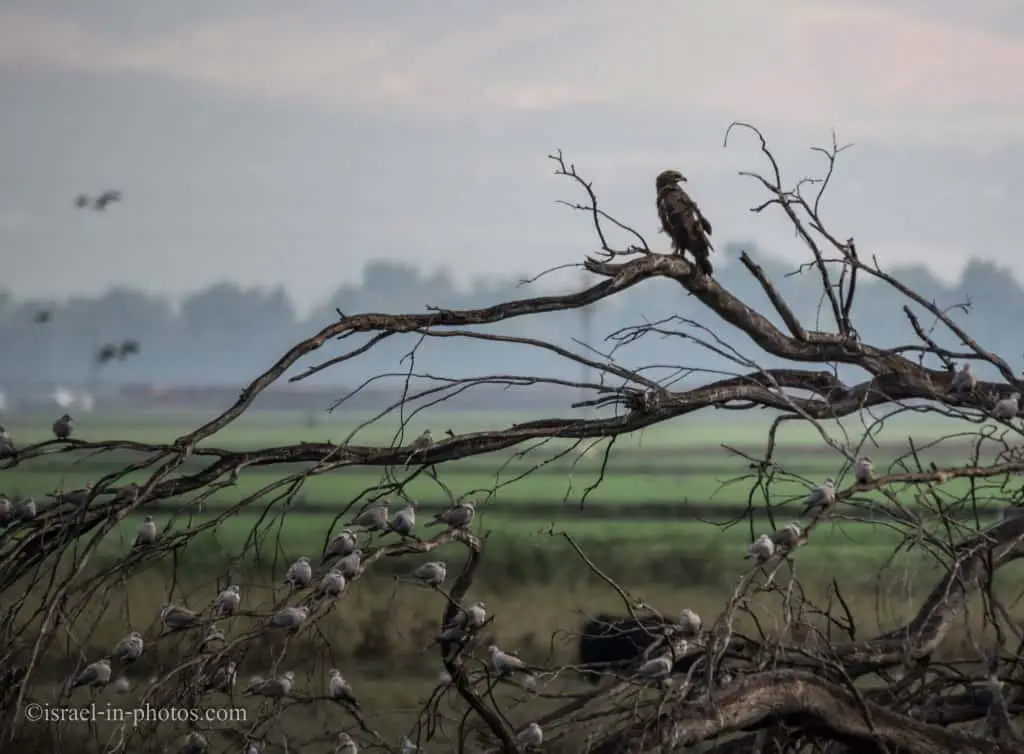
Note: most of these shots were made using Tamron 200 – 500 mm on a Nikon D610. Hopefully, this will give you a distance measure.
Additional Birdwatching Places
If you love birds, check out the following places:
- My favorite places to see bird migration:
- Lovely short family hikes to see birds:
- Agamon Poleg – Short Birding Family Trip around Lake Udim
- Agamon Hefer – Visitors Guide – Bird Watching Park near Netanya
- Hod HaSharon Park – Park by Ecological Lake
- Taninim Stream Nature Reserve
- Hula Nature Reserve and Agamon Hula versus Hula Nature Reserve – Which one is Better?
- Rosh Tzipor Birdwatching Center
- Ein Afek Nature Reserve and Bird Ringing at Ein Afek Nature Reserve
- For people who love parrots:
Additionally, see Zoos and Aquariums in Israel – Full Review (Overview of 30+ places)
Agamon Market
Note: In 2025, due to the war, the Agamon market was closed. Hopefully, it will be reopened in the near future.
Near the entrance to Agamon Hula, you will see a newly constructed mall. It is called Agamon Market and reminds Sarona Market in Tel Aviv. Similar to Sarona, there are mostly food stands and restaurants.
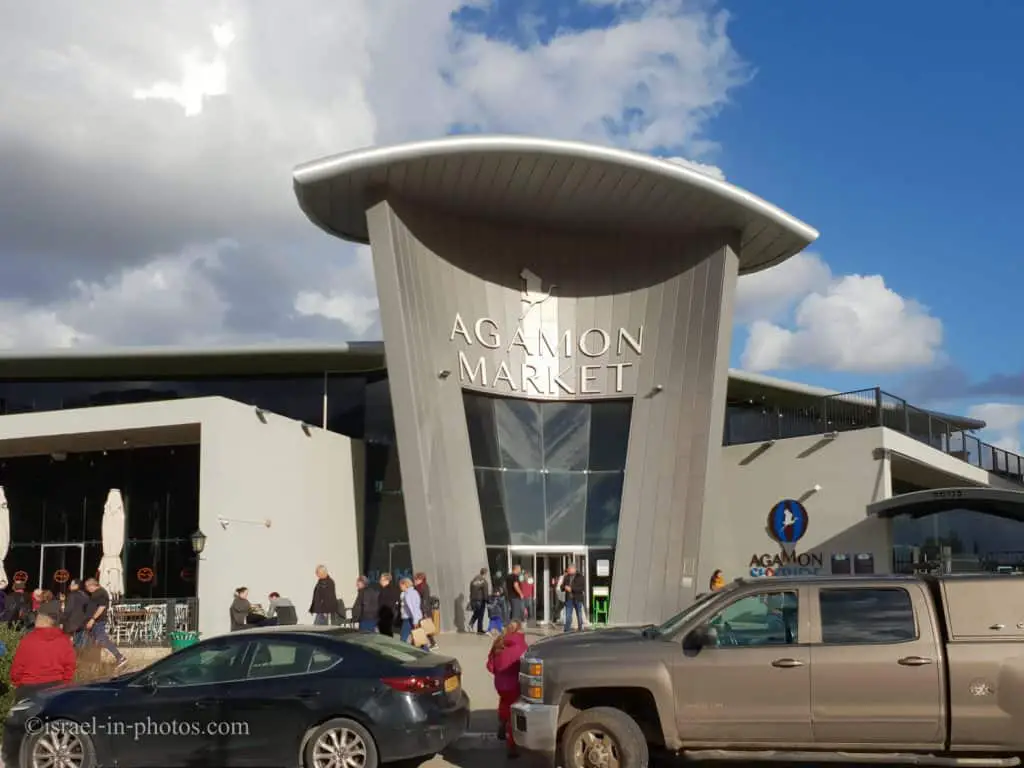

Agamon market is open daily from 10:00 to 17:00 (till 15:00 on Friday).
Besides eating and shopping, you can also ride in a hot air balloon. During our latest visit, it was windy. Thus, the balloon was grounded.
You can find additional details at the official site.
About Agamon Hula
The Agamon Hula Ornithology (Bird Watching) and Nature Park is situated in the heart of the Hula Valley. The valley bordered by mountain ranges, to the east the Golan Heights and to the west the Naphtali Range, is critically located in the center of the Afro-Syrian Rift and one of the most significant bird migration routes in the world. During every migration season (fall and spring), over 500 million birds from more than 400 species migrate in the skies above us. Thousands remain at the Agamon during the winter, and others choose to nest here during the spring and summer.
In the area of the Agamon Hula, a unique ecosystem of regional and international importance has developed. The park is a highly significant and prominent center for eco-tourism in Israel and throughout the world and a model for cooperation between nature, tourism, and agriculture.
Source: official site
History Of Hula Valley
Hula Nature Reserve and Agamon Hula are both located in the Hula Valley. And this valley has an interesting history, including swamp drainage and refilling it back with water.
Before its drainage in the early 1950s, Lake Hula was 5.3 kilometers long and 4.4 kilometers wide, extending over 12-14 square kilometers. It was about one and a half meters deep in summer and three meters deep in winter. Some perennial springs fed the marsh-like lake. The lake attracted human settlement from early prehistoric times. Paleolithic archaeological remains were found near the Bnot Yaakov (“Daughters of Jacob”) bridge at the valley’s southern end. Enan (Mallaha), the first permanent settlement, dated from 9,000-10,000 years ago and was discovered in the valley.
Traditional crops were rice (as early as the Hellenistic period), cotton and sugar cane (brought by the Arabs following their conquest in 636), sorghum, and maize (brought after the discovery of the Americas). Water buffalo were introduced in the eighth century supplying milk and serving as beasts of burden.
The source for this and the following quote is Wikipedia.
Swamp Drainage
The draining operations, carried out by the Jewish National Fund (JNF), began in 1951 and were completed by 1958. It was achieved by two main engineering operations: the deepening and widening of the Jordan River downstream; and two newly-dug peripheral canals diverting the Jordan at the north of the valley. The drying out caused the extinction of the unique endemic fauna of the lake, including the cyprinid fish Acanthobrama hulensis and cichlid fish Tristramella intermedia.
Though perceived at the time as a great national achievement for Israel, with the advent of the modern environmental movement, it became evident that the transformation of the swamp into agricultural land involved significant trade-offs and had effects on the ecosystem. The compromises had not been perceived in the first half of the twentieth century when the primary concerns had been the reduction of malaria-bearing mosquitoes and improving economic productivity. In 1963, a small (3.50 km²) area of recreated papyrus swampland in the southwest of the valley was set aside as the country’s first nature reserve. Concern over the draining of the Hula was the impetus for creating the Society for the Protection of Nature in Israel.
Draining Hula turned out to be a mixed blessing. Water polluted with chemical fertilizers began flowing into Lake Kinneret (Sea of Galilee), lowering the quality of its water. The soil, stripped of natural foliage, was blown away by strong winds in the valley, and the peat of the drained swamp ignited spontaneously, causing underground fires that were difficult to extinguish. Eventually, part of the valley was transformed back into a wetland habitat.
Note: after one of our visits, on our way back, we passed near the Sea of Galilee, and I shot the following panorama.
There are many attractions in this area, and you can either browse the map at the beginning of this post or check out my guide to the Sea of Galilee.
Common Questions
The best way to know what birds are currently on-site is by visiting the official Facebook page. Also, check out the “What is the Best Time To Visit Hula Valley?” section above.
Summary
Visiting Agamon Ha-Hula is one of the top experiences animal and bird lovers can have in Israel. And the sunrise tour takes it to a new level. If you are considering a visit to Agamon, this is probably the best way to do it. I would recommend it to all animal lovers. Being in a place with thousands of birds around you is a great experience. But you should do it only during the migration season.
Note: check out Agamon Hula versus Hula Nature Reserve – Which one is Better? for a comparison of the two places.
Have you ever been to Agamon Hula? Tell us about your experience in the comments below.
That’s all for today, and I’ll see you on future travels!
Stay Tuned!
Additional Resources
Here are several resources that I created to help travelers:- Trip Planner with Attractions and Itineraries is the page that will help you create your perfect travel route.
- What is the Best Time to visit Israel? To answer this question, we will consider the weather, prices, holidays, festivals, and more.
- Information and Tips for Tourists to Israel will answer the most common questions tourists have about Israel (including safety, passports, weather, currency, tipping, electricity, and much more).
- Israel National Parks and Nature Reserves include a complete list, top ten, map, tickets (Israel Pass, Matmon, combo), and campsites.
- If you are looking for things to do, here are the pages for Jerusalem, Tel Aviv, Haifa, Sea Of Galilee, Akko (Acre), Eilat, Nazareth, Safed (Tzfat), and Makhtesh Ramon.



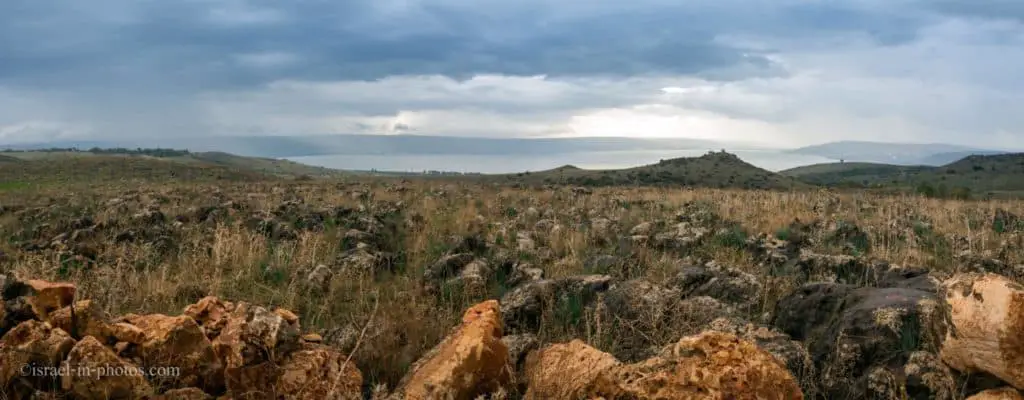


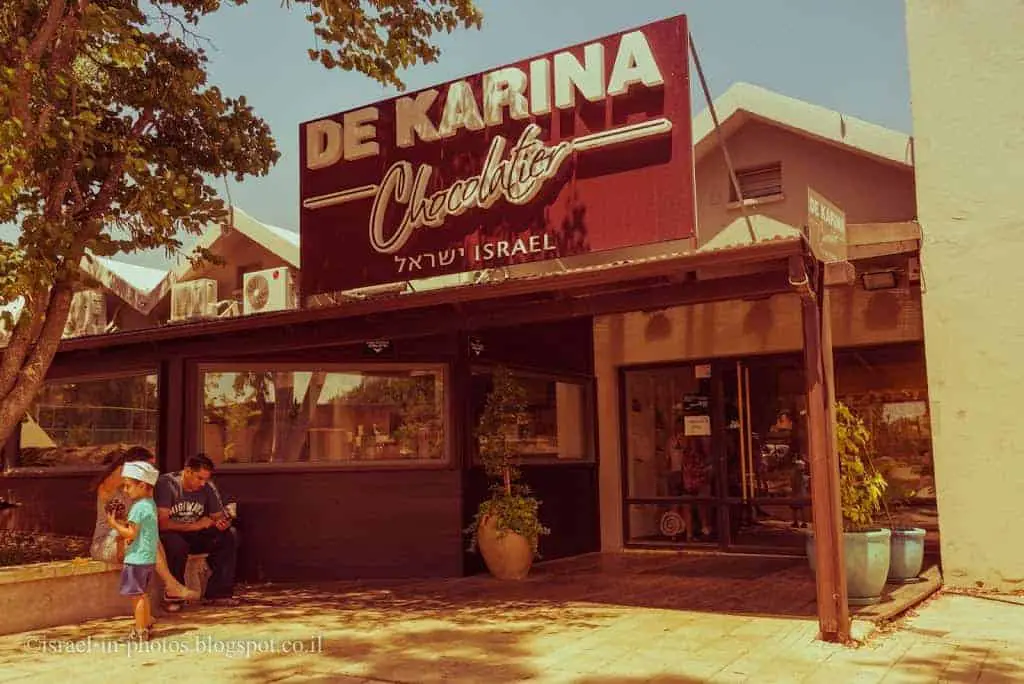


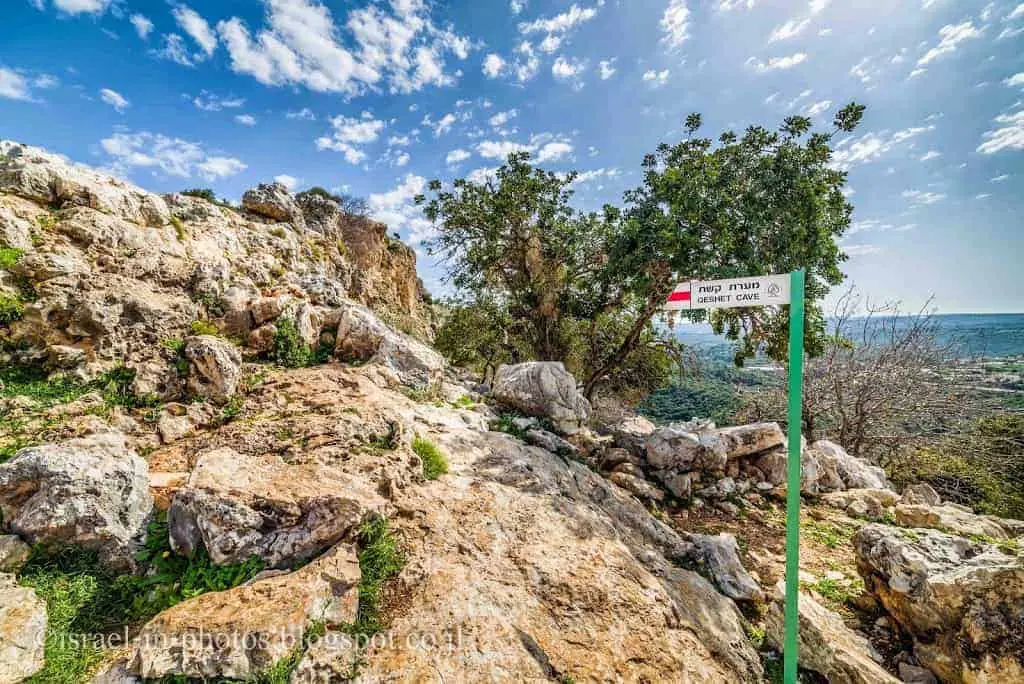
I am trying to book a sunrise tour at Hula lake but can’t find where to pre-register. Can you help me? Thanks
Hi Judy,
You can book tickets here: https://tickchak.co.il/11483/form/tickets
You can also reach this link from the official site. There you choose the date, what tickets you want and then you can purchase the extra activities, like the sunrise tour (that website is only in Hebrew). Usually, the sunrise tours are only on weekends (Friday and Saturday).
If you are interested in a tour in English or want to consult them, you can contact them at 04-6817137 or agamon@agamon-hula.co.il
Thanks for the article!